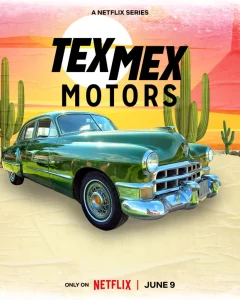What Kind of Gold Is This?
Posted By Jocelynn Cordes On In North American New Right | Comments DisabledA few weeks ago, after I had just completed an essay [2] that touched on the unequal distribution of interest in machines across racial groups (and in which I referred specifically to the demonstrable lack of African interest in engines), I was in the mood to watch a car show. Netflix has many options in that line, and I just happened to choose Tex Mex Motors, a show about a group of mechanics who set up shop on the Mexican border in El Paso, Texas.
The point of establishing themselves on the border is to make their Mexican raids easier — raids on junkyards and private yards [3] overgrown with weeds and dotted with rotting cars, vans, and buses.
The object? To find gold.
It takes considerable knowledge of cars as well as the market to recognize this “gold” for the treasure it is. Sometimes these mechanics haul nothing but rusty — and often incomplete — shells [4] back to Texas, consisting of metal that may or may not still be attached to the machinery that formerly made them moving vehicles. These rust buckets are purchased only after haggling with their owners who, at least for the purposes of the show, appear quite reluctant to part with their once-useful pieces of junk.
What marks any particular piece as “gold” is its original make, model, and year. Their value is certainly not in the engine, though not because those may be old and non-functional. It’s because engines can always be replaced or exchanged, even in new cars, whereas the body of a car is what makes it what it is. (The exception to this would be those rare creations of famous hybrids, such as Shelby’s AC Cobra, which is famous for its particular combination of an Ace chassis and the Ford V8.) Thus, for the team at Tex Mex Motors the focus is on the shell [5] of a particular make and model that, in the mind of American collectors, is quite desirable. These shells are then reconstructed back to their original shapes or else creatively modified, using original pieces as much as possible and fitted out with an appropriate — and much newer — engine that could be from any engine manufacturer.
 [6]
[6]You can buy K. M. Breakey’s Shout: The Battle Cry of Freedom here. [7]
It is certainly necessary to see [8] these transformations in order to appreciate them. The series shows as much of this process as it can without boring viewers to tears, while still revealing some hint of just how arduous and time-consuming the work is. Although since this is not a forum for motorheads, I’ll get to my point.
It wasn’t until I (all too recently) began reading the work of those on the dissident Right that I encountered the phrase “magic dirt.” Before this, I had certainly thought that those who saw America as a land of opportunity were way off base. To me, it wasn’t the land that makes an appreciable difference in Americans’ economic lives so much as the ideas we hold, as reflected in our Constitution and government. I could never understand how Mexico, with its fantastically long coastline of beaches, couldn’t make a better go of it, at least as a tourist destination. At the time I thought it all boiled down to stupid, corrupt governments — of which there happens to be a surfeit below the United States’ southern border.
The “magic dirt” theory, heaping deserved scorn as it does on the idea that all people have to do to achieve economic prosperity is cross a border and transfer themselves and their families from “tragic dirt” to “magic dirt,” is predicated on the understanding that it’s a particular people that creates prosperity, not the landscape or even the government. This might explain why a nation with what appears to be a largesse of resources can still be an economic wasteland. The people there simply don’t know what to do with their natural windfall or how to profit from it.
Enter the example of Tex Mex Motors, where we see white American scavengers — with the help of one rather loopy Mexican — scrounging junkyards in Mexico for profit-yielding treasures. One might reasonably ask why they don’t do this in America. The answer is simply that here, the junkyards know what they’ve got, and know how to get their treasures into the hands of American mechanics and body-workers who know exactly what to do with them. Consequently, American “junk” is sold for a far, far higher price than it is in Mexico.
Unfortunately for the Mexicans, it’s not as if they don’t know what their rotting shells are worth; they just don’t have a market for the vehicles before their transformation. That’s why it takes a team of American mechanics to exploit these graveyards — and turn this gold into profit.
Except that it isn’t really gold, is it? It’s elbow grease.
* * *
Like all journals of dissident ideas, Counter-Currents depends on the support of readers like you. Help us compete with the censors of the Left and the violent accelerationists of the Right with a donation today. (The easiest way to help is with an e-check donation. All you need is your checkbook.)
For other ways to donate, click here [9].
